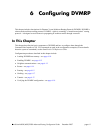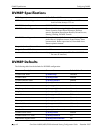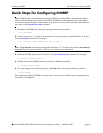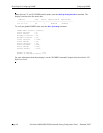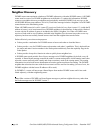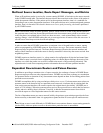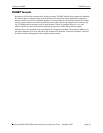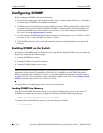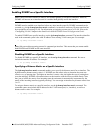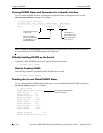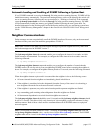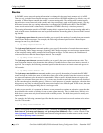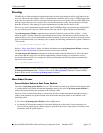
DVMRP Overview Configuring DVMRP
page 6-8 OmniSwitch 6800/6850/9000 Advanced Routing Configuration Guide December 2007
Pruning Multicast Traffic Delivery
Initially, all interfaces with downstream-dependent neighbors are included in the downstream interface list
and multicast traffic is flooded down the truncated broadcast tree to all possible receivers. This allows the
downstream routers to be aware of traffic destined for a particular Source, Group (S, G) pair. The down-
stream routers then have the option to send prunes (and subsequent grafts) for this (S, G) pair as require-
ments change.
A DVMRP router will remove an interface from its forwarding list that has no group members associated
with an IP multicast packet. If a router removes all of its downstream interfaces, it notifies the upstream
router that it no longer wants traffic destined for that particular (S, G) pair. This is accomplished by send-
ing a DVMRP Prune message upstream to the router expected to forward packets from that particular
source.
A downstream router will inform an upstream router that it depends on the upstream router to receive
packets from particular source networks by using the poison reverse technique during the exchange of
Route Report messages. This method allows the upstream router to build a list of downstream routers on
each interface that are dependent upon it for packets from a particular source. If the upstream router
receives Prune messages from each one of the dependent downstream routers on an interface, then the
upstream router can in turn remove this interface from its downstream interface list. If the upstream router
is able to remove all of its downstream interfaces in this manner, it can then send a DVMRP Prune
message to its upstream router. This continues until all unneeded branches are removed. Refer to
“Pruning” on page 6-15 for more specific information on pruning.
Grafting Branches Back onto the Multicast Delivery Tree
A pruned branch will be automatically reattached to the multicast delivery tree when the prune times out.
However, the graft mechanism provides a quicker method to reattach a pruned branch than waiting for the
prune to time out. Without the graft mechanism, the join latency for new hosts in the group might be unac-
ceptably great, because the prunes in the upstream routers would have to time out before multicast traffic
could again begin to flow to the pruned branches. Depending on the number of routers along the pruned
branch and the timeout values in use, several minutes might elapse before the host could begin to receive
multicast traffic. By using a graft mechanism, DVMRP reduces the join latency to a few milliseconds.
The graft mechanism is made reliable through the use of Graft-Ack (Graft Acknowledgment) messages. A
Graft-Ack message is returned by the upstream router in response to a Graft message. If the Graft-Ack
message is not received, the downstream router will resend the Graft message. This prevents the loss of a
Graft message due to congestion.
The ip dvmrp graft-timeout command enables you to set the Graft message retransmission value. This
value defines the duration of time that the router will wait before retransmitting a Graft message if it has
not received a Graft-Ack message. Refer to “Grafting” on page 6-17 for more information.




